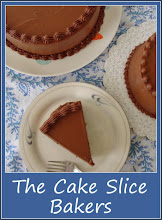The May 2010 Daring Bakers’ challenge was hosted by Cat of Little Miss Cupcake. Cat challenged everyone to make a piece montée, or croquembouche, based on recipes from Peter Kump’s Baking School in Manhattan and Nick Malgieri.
When I first saw this months challenge I was excited and a little daunted by the prospect of making a piece montée or croquembouche. A croquembouche is a tall tower of choux buns, stuck together with chocolate or caramel and often served at weddings or other elaborate occasions. In order to complete the challenge we had to make 3 required elements of the dish: the pate a choux, the crème patissiere, and the glaze used to mount/decorate it.
Even though we had to make the three required elements, how we presented the finished recipe was up to us. This made me much happier as it meant I could make smaller individual piece montée without having to create one huge desert. I adore pastry cream or crème patissiere, it’s so much nicer and more flavoursome than standard cream. For my crème patissiere I decided to replace the milk with coconut milk in order to add an extra flavour dimension to the dish. I also selected to make the chocolate glaze rather than the caramel to accompany the dessert as I thought the chocolate would complement the coconut better.
I have made choux buns many times before, but this recipe proved to be a winner. It produced perfectly shaped little hollow buns, that were nicely golden brown and just the right combination of crisp and softness. It’s going to be my ‘go-to’ choux pastry recipe from now on. All the buns turned out perfectly formed.
The coconut crème patissiere also worked well and was incredibly thick and creamy. The coconut flavour really shone through and made it seem even more indulgent. When paired with the dark bitter chocolate glaze it was just heavenly. I’m not usually a fan of profiteroles but the silky smooth coconut crème encased in the light, crisp choux and topped with the rich bitter glaze was a taste sensation. I think I’ve been converted!
I presented by dessert in individual cocktail glasses which made them elegant enough for a special family dinner party dessert. I urge you to try them, particularly with the coconut crème patissiere, they were out of this world. Thanks Cat for such a divine dessert challenge! Click to see my fellow Daring Bakers desserts.
Coconut & Chocolate Piece Montée Croquembouche
Coconut Crème Patissiere
225ml whole milk (I used coconut milk)
2 tbsp cornflour
50g caster sugar
1 large egg
2 large egg yolks
30g unsalted butter
1 tsp vanilla extract
Method
Dissolve the cornflour in 55ml of milk. Combine the remaining milk with the sugar in a saucepan; bring to boil and then remove from heat.
Beat the whole egg and egg yolks into the cornflour mixture. Pour 1/3 of boiling milk into the egg mixture, whisking constantly.
Return the remaining milk to the heat. Pour in the hot egg mixture in a stream, continuing whisking.
Continue whisking (this is important – you do not want the eggs to solidify/cook) until the cream thickens and comes to a gentle boil, about 3-4minutes. Remove from heat and beat in the butter and vanilla.
Pour the thickened cream into a small clean bowl. Press clingfilm firmly against the surface to prevent a skin from forming. Allow to cool slightly before refrigerating until required.
Can be made the day before.
Pate a Choux
175 ml water
85g unsalted butter
¼ tsp salt
1 tbsp caster sugar
120g plain flour
4 large eggs
For Egg Wash: 1 egg and pinch of salt
Method
Pre-heat oven to 220C degrees. Line two baking sheets with parchment or silicon paper.
Combine the water, butter, salt and sugar in a saucepan over medium heat. Bring to a boil and stir occasionally. Once boiling, remove from the heat and pour in the flour. Immedietly beat vigeriously to encorporate the flour and prvent lumps from forming until it forms a thick dough.
Return the dough to heat and cook, stirring constantly until the batter dries slightly and begins to pull away from the sides of the pan.
Transfer to a bowl and stir with a wooden spoon for 1 minute to cool slightly.
Add 1 egg and beat in well. The dough will break up into lumps and look shiny, but this is normal. Keep beating and it will come back together.
Then add in the next egg and repeat the process until you have incorporated all the eggs.
Transfer batter to a pastry bag fitted with a large open tip. Pipe the choux about 1 inch-part in the baking sheets. Hold the bag in place and pipe out a small round blob. Choux should be about 1 inch high about 1 inch wide.
Using a clean finger dipped in hot water, gently press down on any tips that have formed on the top of choux when piping. You want them to retain their ball shape, but be smoothly curved on top.
Brush tops with egg wash (1 egg lightly beaten with pinch of salt).
Bake at 220C for 10 minutes, until well-puffed and turning lightly golden.
Lower the temperature to 180C and continue baking until browned and dry, about 15-20 minutes more. Transfer to a cooling wire to cool.
Store in a airtight box until required. Makes about 25-30 buns.
Filling the choux
When you are ready to assemble your piece montée, fill a pastry bag fitted with a small plain nozzel with the crème patissiere. Pierce the bottom of each choux with the tip of the nozzel and fill with the crème.
Have these all ready before you make the sauce/glaze.
Chocolate Glaze
200g dark chocolate, about 60% coco solids
150ml milk
Method
Break the chocolate into small pieces and place in a small saucepan long with the milk. Heat gently, stirring occasionally until the chocolate has melted and combined with the milk. Keep heating until the sauce thickens into a thick glossy sauce. Remove from the heat and use immediately.
Assembly of the Piece Montée
Once you are ready to assemble your piece montée, dip the top of each choux in your glaze (careful it may be still hot!), and start assembling on your cake board/plate/sheet. You can make mini individual ones or one large one. If making a large one, then you want to form the buns into a circle no bigger than 8inch/20cm in diameter. Continue dipping and adding choux to build up a tower of buns, which gets smaller with each layer. Use the glaze to hold them together as you build up.
When you have finished the design of your piece montée, drizzle with remaining glaze over the top and add additional ribbons, sugar decorations, nuts of flowers as you wish to decorate.
Makes 1 large or 6 individual Piece Montee’s
























































